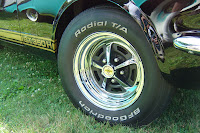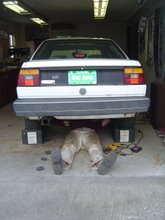Of course, as a car nut, I spend my time off tinkering in the garage or traveling hundreds of miles to far-flung car shows. This last weekend I went to the New England Summer Nationals in Worcester, Ma – that’s pronounced Wista or Wooster depending on your geographic orientation. The Summer Nationals is tradition for me and I look forward to this annual Muscle car exposition with the same sort of zeal that my daughter chases the ice cream truck. With more than 6000 classic cars, drag racing, burn-out competitions, vendors, swap meet and a bikini contest there is certainly a lot to see and do. And the people at this show-both vendors and car owners-are fantastic. I spent nearly an hour talking to one guy about his ’86 Monte Carlo. I had never met this guy before but he was willing to bare his soul and tell me everything, even about the rust on his car’s frame. That’s a pretty deep and tender subject for most hotroders.
What makes this annual show really fantastic is the variety. Sure, the staples of the classic car culture are represented in great number. There are gads of Camaros, Mustangs and the like. But, every year, I am surprised by the number of off beat cars that make an appearance. These are the cars that command a niche following at best.
 The Dodge Omni, with its boxy and upright lines, is a seemingly unlikely canvas for hotrodding. However, in 1984, the Dodge Omni GLH hit the streets as Mopar's answer to the hotrodded Volkswagen GTi hatchback. And, with a carburated 2.2L in-line four that produced 110hp, the light-weight Omni was right on track with the souped-up Rabbit. The "GLH" moniker is rumored to have been the invention of Carol Shelby himself. The story is that Shelby suggested the car be called the GLH because it "goes like hell."
The Dodge Omni, with its boxy and upright lines, is a seemingly unlikely canvas for hotrodding. However, in 1984, the Dodge Omni GLH hit the streets as Mopar's answer to the hotrodded Volkswagen GTi hatchback. And, with a carburated 2.2L in-line four that produced 110hp, the light-weight Omni was right on track with the souped-up Rabbit. The "GLH" moniker is rumored to have been the invention of Carol Shelby himself. The story is that Shelby suggested the car be called the GLH because it "goes like hell." To add to this "no nonsense attitude" the GLH came fitted with side skirts, a louvered hood and 15 inch aluminum alloy wheels. This was pretty heady stuff for 1984 but the best was yet to come. For 1985, the Omni GLH was made available with a 146 hp turbo-charged four-cylinder. The svelte Omni GLH, weighing in at 2400 pounds, was capable of besting contemporary Mustangs and Camaros. The madness, however, didn't end there. Carol Shelby, of Mustang fame, took into custody 500 turbo Omnis. A Shelby Omni, known as the Omni GLHS, came with a stiffer suspension that included Koni shocks and an intercooler to help handle the temperatures associated with running 12 pounds of boost. The Omni GLHS was capable of covering the quarter mile in less than 15 seconds. In those days that was fast enough to stomp a stock Corvette.
To add to this "no nonsense attitude" the GLH came fitted with side skirts, a louvered hood and 15 inch aluminum alloy wheels. This was pretty heady stuff for 1984 but the best was yet to come. For 1985, the Omni GLH was made available with a 146 hp turbo-charged four-cylinder. The svelte Omni GLH, weighing in at 2400 pounds, was capable of besting contemporary Mustangs and Camaros. The madness, however, didn't end there. Carol Shelby, of Mustang fame, took into custody 500 turbo Omnis. A Shelby Omni, known as the Omni GLHS, came with a stiffer suspension that included Koni shocks and an intercooler to help handle the temperatures associated with running 12 pounds of boost. The Omni GLHS was capable of covering the quarter mile in less than 15 seconds. In those days that was fast enough to stomp a stock Corvette.The 85 Omni GLHS pictured here is number 127 of 500. Note the dash plaque signed by Carol Shelby that shows this number. Also, note the decal added to the speedometer by a previous owner that enumerates speeds above 85mph. This is an interesting artifact of the gas-crunch, a time when we all were suppose to drive slower and never, at any cost,
 exceed 55mph.
exceed 55mph.I want to thank, Dave, the owner of this car for letting me crawl in and out of his pristine Omni GLHS. Dave was dismayed by the lack of representation of front-wheel-drive Mopars at the show. So, if you are reading this and you own a Rampage, Charger or hopped-up Omni, next year you might want to wheel your way over to Summer Nationals.
During this same era, Chevy offered up its own hot-hatch racer. The X-11, like the GLH, came from humble roots. The Chevy Citation, on which the X-11 was based, debuted in 1980 as a fuel-sipping, front-wheel-drive econowagen. Powered by a carburated 115hp 2.8l V6, the Citation was not about to set any land-speed records. Engineers at General Motors, however, had racing in mind for the unlikely compact. And so, the X-11, with an uprated suspension and high output 140 hp V6, was created for SSB/SCCA class racing. The X-11 was available to the public from 1981 to 1985. The high output engine designed for the X-11 featured larger valves, higher compression, and more aggressive camshafts.

This last oddball hotrod is an enigma to me. Is it a golf cart or a shrunken Chevy?

Now, like I said before, there was an abundance of classic muscle cars, a cornucopia of Detroit iron, if you will. I do not have the bandwidth to put up a picture of every cherry Mustang or Malibu. So, I will hit upon a few of the outstanding examples.
 First, take a gander at this restored '66 H
First, take a gander at this restored '66 H ertz Mustang. The Hertz rent-a-racer program created a stir back in the '60s when the company ordered 1000 Shelby GT-350 Mustangs for their rental fleet. The Shelby GT-350 was powered by the same 300hp, 289 cubic-inch V8 that Carol Shelby used in the famed Cobra. Tales abound of customers winning races and car shows
ertz Mustang. The Hertz rent-a-racer program created a stir back in the '60s when the company ordered 1000 Shelby GT-350 Mustangs for their rental fleet. The Shelby GT-350 was powered by the same 300hp, 289 cubic-inch V8 that Carol Shelby used in the famed Cobra. Tales abound of customers winning races and car shows  with rented Hertz Mustangs. Dwayne, the owner of this fine example, explained that the order was never completed and that only 986 Hertz Mustangs were delivered. He also mentioned that some of the Hertz cars were not finished in the signature black and gold.
with rented Hertz Mustangs. Dwayne, the owner of this fine example, explained that the order was never completed and that only 986 Hertz Mustangs were delivered. He also mentioned that some of the Hertz cars were not finished in the signature black and gold.  Next, for viewing is a '68 Pontiac Firebird worthy of envy, lust and other such pagan desires. Just looking at its sleek, alluring lines is to commit so serious a transgression as to render redemption beyond hope. Drink it in, for here is perhaps the finest vintage of Firebird. Note the Pontiac-insignia-shaped indicators adorning this machine's rear flank. In 1968, legislation
Next, for viewing is a '68 Pontiac Firebird worthy of envy, lust and other such pagan desires. Just looking at its sleek, alluring lines is to commit so serious a transgression as to render redemption beyond hope. Drink it in, for here is perhaps the finest vintage of Firebird. Note the Pontiac-insignia-shaped indicators adorning this machine's rear flank. In 1968, legislation  mandating side-indicators lead to the addition of this tasty detail. Also, unlike its Camaro brethren, the grill, bumper and front fascia are all integrated into one sleek and muscular element that does more than hint at the powerful V8 housed beneath the hood. In 1969, the grill would be redesigned into a more gaudy affair that would set the tone and-in my opinion-take the first step toward the ugly and garish Firebirds that would follow during the '70s and through to the model's ultimate demise in 2002.
mandating side-indicators lead to the addition of this tasty detail. Also, unlike its Camaro brethren, the grill, bumper and front fascia are all integrated into one sleek and muscular element that does more than hint at the powerful V8 housed beneath the hood. In 1969, the grill would be redesigned into a more gaudy affair that would set the tone and-in my opinion-take the first step toward the ugly and garish Firebirds that would follow during the '70s and through to the model's ultimate demise in 2002. The first Firebird debuted in 1967 and shared its platform with the Chevy Camaro. Incidentally, another pony car, the Mercury Cougar made its first appearance in 1967. The Cougar was built on the underpinnings of the Ford Mustang.
I have never seen a four-wheel-steering firetruck before, nor a four-wheel steering vehicle of any sort. Neither had any of the rubber-necking folks in the photo below. I didn't get to talk to the owner because he wouldn't stop driving the thing around.

Finally, here is a well done third generation Chevy Malibu wagon. Why feature a wagon when there were countless Malibu coupes fielded at the show? Because, it is easy to duplicate that which is accepted and has been done before. It is much riskier to strike out and create something fresh. Besides, wagons are cool.

The third generation Malibu-although by comparison a downsized sedan-replaced the Chevelle as Chevy's midsized offering. Previous Chevelles had offered the Malibu nameplate only as a mid-range trim package. The top trim offering being the Laguna.
The third generation Malibu was available in three body styles: two-door coupe, four-door sedan and four-door wagon. These Malibus were powered by either a 305 cubic inch V8 or a 229 cubic inch V6.
That's all for now. Coming soon, unsanctioned burn-outs, bikini-clad babes and more classic road machines.




No comments:
Post a Comment